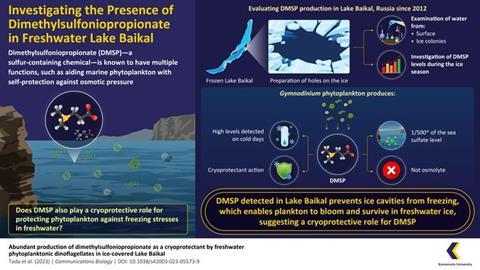Phytoplankton or microalgae found in the ocean are often known to produce a sulfur-containing chemical called dimethylsulfoniopropionate (DMSP).
This organic molecule breaks down to release a strong but sweet-smelling gas called dimethyl sulfide (DMS), which plays a major role in the formation of cloud condensation nuclei and is also associated with the smell of the sea. More importantly, DMSP acts as an osmolyte and thus protects the phytoplankton against the osmotic pressure created by saline water.

Scientists have, however, hypothesized that zwitterionic DMSP - an ion containing both positive and negatively charged functional groups - must also have a role beyond osmotic regulation. Past studies have shown that marine algae in colder oceans produce more DMSP than those found in warmer oceans.
Moreover, studies have also revealed that the concentration of DMSP in the ocean decreases as the seasonal temperature rises. Conversely, the abundance of DMSP increases at low temperatures. This could mean that DMSP plays a cryoprotective role for the survival of planktons. In other words, it can act as a substance that protects biological material from damage on being exposed to stresses such as freezing temperatures.
Cryoprotective role
With the aim of deciphering the cryoprotective role of DMSP for marine algae, a team of researchers from Kumamoto University and Limnological Institute, Russian Academy of Sciences, led by Professor Kei Toda, investigated the presence of DMSP in Lake Baikal in Russia, the world’s clearest freshwater lake.
Since 2012, the team has been tracking seasonal variations in phytoplankton and DMSP concentration in the ice-covered Lake Baikal. The results of this decade-long study were recently published in Communications Biology on 24 November 2023.
“During one of our previous studies, local people reported DMS-like odors from the lake during the ice-melting season. Pollution was an unlikely source, so the other factor could be the conversion of DMSP by the phytoplankton to DMS. Since freshwater algae do not need osmolytes like their marine counterparts do, this piqued our interest to explore its role further,” reveals Prof. Toda.
Expeditions for phytoplankton
The team has conducted eight expeditions to Lake Baikal since 2012 to search for phytoplankton production and analyzing DMSP and related chemicals. To analyze DMSP levels, the researchers dug two ice holes of about 70 cm in diameter in the lake during the spring season (around March). They obtained water samples daily from the surface of the lake and from within the ice colonies where the phytoplankton Gymnodinium baicalense bloomed during spring.

The team found that the Gymnodinium in the ice colonies produced DMSP and released it into the water during the ice-melting season. Their analysis showed that DMSP concentrations were higher on cold days and lower when temperatures were higher than the freezing point.
Phytoplankton use the sulfur atom from the sulfate ions present in seawater to produce DMSP. The results of this study showed that despite the sulfate concentration in Lake Baikal being 1/500th of the concentration found in seawater, the freshwater plankton Gymnodinium effectively used their limited sulfur resource to synthesize DMSP in their cells and survived in freshwater ice.
Culture experiments
The observations and the analysis carried out since 2012 validated the role of DMSP as a cryoprotectant for freshwater algae. “Our results can be further verified by culture experiments at different temperatures and by identifying the genes responsible for DMSP production by freshwater algae,” points out Prof. Toda, on being asked about the possible future direction of this line of research. While the production of DMSP by marine plankton for coping up with osmotic pressure was known, this study is the first to confirm the production of DMSP by freshwater planktons, which do not require osmotic adjustments.
Overall, the findings of this research lay a solid groundwork for further exploration of DMSP production by algae and their functions in other ecosystems such as boreal lakes, glaciers, and alpine snow.







No comments yet